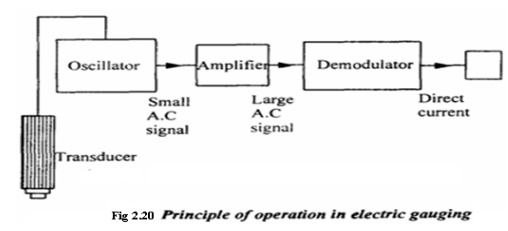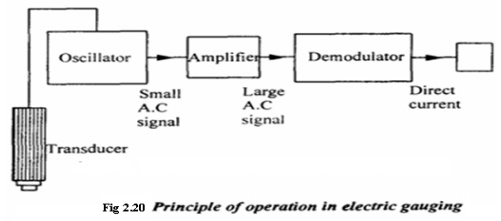Chapter: Mechanical : Metrology and Measurements : Linear and Angular Measurements
Electronic comparator

ELECTRONIC COMPARATOR
In electronic comparator, transducer induction or the principle of application of frequency modulation or radio oscillation is followed.

Construction details
In the electronic comparator, the following components are set as follows:
i. Transducer
ii. Oscillator
iii. Amplifier
iv.Demodulator
v. Meter
(i) Transducer
It converts the movement of the plunger into an electrical signal. It is connected with oscillator.
(ii) Oscillator
The oscillator which receives electrical signal from the transducer and raises the amplitude of frequency wave by adding carrier frequency called as modulation.
(iii) Amplifier
An amplifier is connected in between oscillator and demodulator. The signal coming out of the oscillator is amplified into a required level.
(iv) Demodulator
Demodulator is nothing but a device which cuts off external carrier wave frequency. i.e. It converts the modulated wave into original wave as electrical signal.
(v) Meter
This is nothing but a display device from which the output can be obtained as a linear measurement.
Principle of operation
The work to be measured is placed under the plunger of the electronic comparator. Both work and comparator are made to rest on the surface plate. The linear movement of the plunger is converted into electrical signal by a suitable transducer. Then it sent to an oscillator to modulate the electrical signal by adding carrier frequency of wave. After that the amplified signal is sent to demodulator in which the carrier waves are cut off. Finally, the demodulated signal is passed to the meter to convert the probe tip movement into linear measurement as an output signal. A separate electrical supply of D.C. is already given to actuate the meter.
Advantages of Electrical and Electronic comparator
1) It has less number of moving parts.
2) Magnification obtained is very high
3) Two or more magnifications are provided in the same instrument to use various ranges.
4) The pointer is made very light so that it is more sensitive to vibration.
5) The instrument is very compact.
Disadvantages of Electrical and Electronic comparator
1) External agency is required to meter for actuation.
2) Variation of voltage or frequency may affect the accuracy of output.
3) Due to heating coils, the accuracy decreases.
4) It is more expensive than mechanical comparator.
Related Topics